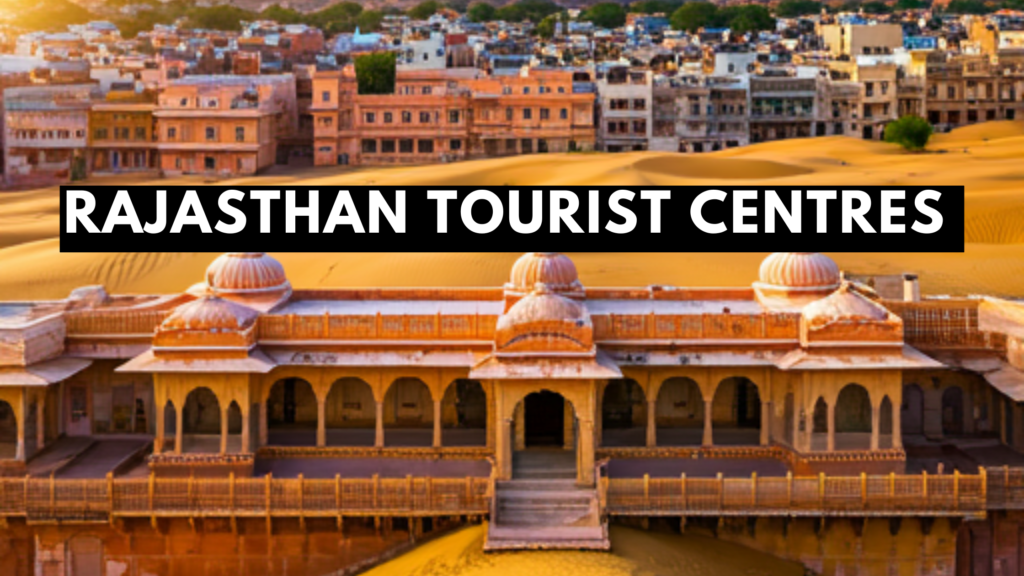Geography of Rajasthan: Tourist Centres & Circuits: Rajasthan, the largest state in India, is known for its diverse geography, rich cultural heritage, history, and tourism potential. The state has been divided into several tourism circuits, each with its unique geographical and cultural features, making it a major tourist destination for both domestic and international. In this article/post we provide detailed overview of the tourist centres and circuits in Rajasthan, useful for RPSC RAS exam preparation.
Also, check: Geography of Rajasthan For RPSC RAS Prelims
Rajasthan: Tourist Centres & Circuits

- The Desert Circuit
- The Mewar Circuit
- The Shekhawati Circuit
- The Aravalli Circuit
- The Hadoti Circuit
- Wildlife and the Eco-tourism Circuit
- The Socio-Religious Circuit
Understanding these tourist centre and circuits is important for competitive exams like RPSC RAS, as it highlights the significance of tourism in Rajasthan’s History, Economy and Geography.
Also, check: RPSC RAS Prelims Exam 2024 | General Knowledge and General Science
1. The Desert Circuit
Key Features:
- It is located in the western part of Rajasthan, dominated by the Thar Desert.
- Arid climate, sand dunes, and sparse vegetation are the characteristic features.
Major Tourist Centres:
- Jaisalmer: Known as the “Golden City,” famous for Jaisalmer Fort, Patwon Ki Haveli, and desert safaris in the Sam Sand Dunes.
- Bikaner: Known for Junagarh Fort, Lalgarh Palace, and the unique Karni Mata Temple (Rat Temple).
- Barmer: Known for its rich cultural traditions and Kiradu Temple ruins.
Importance:
- Represents the desert culture of Rajasthan with folk traditions, camel safaris, and desert camping. The Pushkar Fair is also a major attraction, although geographically it overlaps with other circuits.
2. The Mewar Circuit
Key Features:
- The southern region of Rajasthan, marked by Aravalli Hills and the Udaipur basin.
- Relatively more fertile and forested compared to the desert regions.
Major Tourist Centres:
- Udaipur: The “City of Lakes,” known for Lake Pichola, City Palace, and Jag Mandir.
- Kumbhalgarh: Known for Kumbhalgarh Fort, a UNESCO World Heritage Site, and Kumbhalgarh Wildlife Sanctuary.
- Chittorgarh: Famous for Chittorgarh Fort, associated with historical figures like Rani Padmini and Maharana Pratap.
Importance:
- The Mewar Circuit highlights the royal heritage, battlefields, and architectural marvels of Rajasthan. It is also famous for its lakes and greenery, offering a contrast to the desert regions.
3. The Shekhawati Circuit
Key Features:
- It is located in the northeastern part of Rajasthan, it forms a part of the semi-arid zone.
- This circuit is known for its havelis with intricate frescoes.
Major Tourist Centres:
- Mandawa: Famous for beautifully painted havelis and forts.
- Jhunjhunu: Known for the Khetri Mahal and Rani Sati Temple.
- Nawalgarh: Known for grand havelis such as Poddar Haveli.
Importance:
- Referred to as the “Open Art Gallery” of Rajasthan, the Shekhawati region is notable for its unique style of fresco painting. It provides insights into Rajasthan’s trading communities and their cultural impact.
4. The Aravalli Circuit
Key Features:
- The Aravalli Range stretches across Rajasthan, forming the backbone of its topography.
- This region includes Mount Abu, the only hill station in Rajasthan, providing a cooler climate and lush landscapes.
Major Tourist Centres:
- Mount Abu: Famous for Dilwara Temples, Nakki Lake, and Guru Shikhar (highest point in Rajasthan).
- Guru Shikhar: Offers panoramic views of the Aravalli Range and is home to the Mount Abu Observatory.
Importance:
- The Aravalli Circuit provides a natural retreat from Rajasthan’s harsh climates. Mount Abu, being the only hill station, is a major attraction for both religious and nature tourism.
5. The Hadoti Circuit
Key Geographical Features:
- The hadoti circuit is located in southeastern Rajasthan, this region is known for its major rivers, plateaus, and forests.
- Major rivers include the Chambal, which flows through this region and creates ravines.
Major Tourist Centres:
- Kota: Known for Kota Garh Palace, Kishore Sagar Lake, and Chambal Gardens.
- Bundi: Famous for Taragarh Fort, Bundi Palace, and stepwells like Rani Ji Ki Baori.
- Jhalawar: Famous for its forts and temples, particularly the Gagron Fort, a UNESCO World Heritage Site.
Importance:
- This circuit is relatively less explored but offers unique experiences related to river tourism, forts, and traditional Rajasthani architecture. The Kota Dussehra festival is another major attraction.
6. Wildlife and the Eco-tourism Circuit
Key Features:
- Rajasthan has a variety of wildlife habitats ranging from the Thar Desert to the Aravalli hills and wetlands.
Major Tourist Centres:
- Ranthambore National Park: Known for its Tiger population and The Ranthambore Fort.
- Sariska Tiger Reserve: It is Located in the Alwar district, also known for its historical Kankwari Fort.
- Keoladeo National Park (Bharatpur): A UNESCO World Heritage Site, famous for its bird sanctuary.
- Desert National Park: Located near Jaisalmer, showcasing desert flora and fauna, including Great Indian Bustards.
Importance:
- Rajasthan is home to several protected areas, offering a glimpse of its biodiversity. The Ranthambore and Sariska reserves are renowned for tiger sightings, while Keoladeo attracts bird watchers from around the world.
7. The Socio-Religious Circuit
Key Features:
- It Spread across various parts of Rajasthan, connecting major pilgrimage centres and sacred sites.
Major Tourist Centres:
- Ajmer: Famous for the Ajmer Sharif Dargah, an important Sufi pilgrimage site.
- Pushkar: Known for its Brahma Temple, Pushkar Lake, and the annual Pushkar Camel Fair.
- Mehandipur Balaji Temple: Located near Dausa, known for its unique exorcism rituals.
Importance:
- This circuit offers religious tourism, with millions of pilgrims visiting every year for spiritual solace and participating in festivals.
Rajasthan’s geography provides diverse opportunities for tourism, from the deserts in the west to the Aravalli hills in the east, and the riverine systems in the southeast. The state’s rich cultural history, magnificent forts, palaces, and wildlife reserves make it a major hub for tourism, both domestic and international.
Read more: Rajasthan General Studies | General Knowledge of Rajasthan
